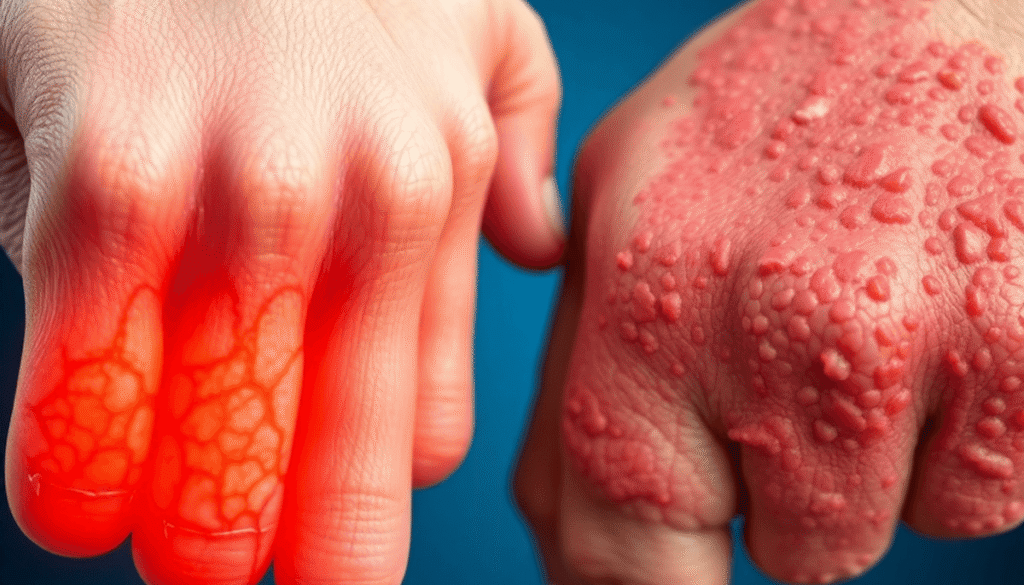Living with Psoriatic Arthritis: Recognizing the Warning Signs
Psoriatic arthritis is a condition that affects both the joints and the skin, impacting up to 30% of individuals with psoriasis. It is a long-lasting inflammatory disorder that presents a unique challenge: dealing with both painful swelling in the joints and the distinctive red, flaky patches of skin associated with psoriasis.
This condition usually develops between the ages of 30 and 55, but it can occur at any age. You may start experiencing symptoms of psoriatic arthritis years after your first psoriasis flare-up, or in some instances, joint issues can arise before any visible skin changes.
Recognizing symptoms early is crucial for your overall health. Studies indicate that promptly identifying and treating psoriatic arthritis can lead to better outcomes such as:
- Preventing irreversible damage to the joints
- Alleviating pain and reducing inflammation
- Preserving flexibility and movement in the joints
- Enhancing your overall well-being
- Slowing down the progression of the disease
By familiarizing yourself with the warning signs of psoriatic arthritis, you can take charge of your health and seek timely medical attention before the condition worsens.
Understanding the Autoimmune Nature of Psoriatic Arthritis
Your immune system typically acts as your body’s defense mechanism against harmful invaders. In psoriatic arthritis, this protective system malfunctions, mistakenly attacking healthy cells in your joints and skin.
This immune system attack triggers two distinct processes:
1. Joint Inflammation
Your immune cells target joint tissues, causing:
- Swelling and tenderness
- Tissue damage
- Pain and stiffness in affected areas
2. Skin Cell Overproduction
The immune response accelerates skin cell growth, resulting in:
- Rapid cell turnover
- Formation of psoriatic plaques
- Thickened, scaly patches on skin
Your risk of developing psoriatic arthritis stems from a complex interplay of factors:
1. Genetic Predisposition
- Family history increases risk
- Specific gene variations linked to condition
- Multiple genes influence disease development
2. Environmental Triggers
- Physical trauma
- Viral or bacterial infections
- Severe stress
- Certain medications
- Smoking
These factors can activate the immune system’s misguided response in genetically susceptible individuals. Research shows that exposure to multiple triggers combined with genetic risk factors increases the likelihood of developing psoriatic arthritis.
Primary Warning Signs to Watch For
1. Joint Pain, Stiffness, and Swelling in Psoriatic Arthritis
Psoriatic arthritis has specific patterns of joint pain that make it different from other types of arthritis. The pain usually affects the same joints on both sides of your body.
Commonly affected areas include:
- Small joints in fingers and toes
- Wrists and ankles
- Knees and elbows
- Lower back and neck
The pain has certain characteristics that can help identify it:
- Severe pain first thing in the morning
- Stiffness lasting 30 minutes or more after waking up
- Pain that gets better with movement
- Swelling that feels warm to touch
When dealing with these symptoms, your daily activities may become difficult:
- Hard time gripping objects or opening jars
- Limited range of motion in affected joints
- Trouble with fine motor tasks like writing or buttoning clothes
- Difficulty walking or climbing stairs due to limited mobility
Signs of inflammatory pain vs. mechanical pain:
Inflammatory Pain
- Gets better with activity
- Worse during rest
- Present even without movement
- Accompanied by visible swelling
- Most severe in early morning
Mechanical Pain
- Gets worse with activity
- Improves with rest
- Triggered by specific movements
- Limited or no visible swelling
- Varies throughout the day
The severity of joint symptoms can change, with times when the disease is more active (flares) alternating with times when it is relatively calm. These symptoms may start slowly in one or two joints before spreading to others over time. By recognizing these early warning signs, you can seek medical help quickly and potentially prevent long-term joint damage.
2. Dactylitis: The Sausage-Like Swelling That Signals Psoriatic Arthritis
Dactylitis creates a distinctive sausage-like appearance in fingers or toes – a telltale sign of psoriatic arthritis. This condition occurs when inflammation affects both the joints and surrounding soft tissues simultaneously.
Key characteristics of dactylitis include:
- Uniform swelling along the entire length of fingers or toes
- Redness and warmth in the affected digit
- Restricted movement and flexibility
- Pain that ranges from mild to severe
You can identify dactylitis by comparing your digits side by side. An affected finger or toe appears noticeably larger than its counterpart, resembling a small sausage. The swelling typically extends beyond a single joint, encompassing the entire digit.
This symptom holds significant diagnostic value – research shows that 40% of people with psoriatic arthritis experience dactylitis. Medical professionals consider it a hallmark sign when evaluating potential cases of psoriatic arthritis, particularly in distinguishing it from other forms of arthritis where this type of swelling rarely occurs.
The presence of dactylitis often indicates active disease progression and may require immediate medical attention to prevent joint damage.
3. Enthesitis: Foot Pain at Tendon and Ligament Attachments in Psoriatic Arthritis
Enthesitis creates distinct pain patterns at specific points where tendons and ligaments connect to bones. This hallmark symptom of psoriatic arthritis commonly affects the feet, particularly the Achilles tendon and plantar fascia.
You might experience:
- Sharp heel pain when taking first steps in the morning
- Intense discomfort at the back of your heel
- Pain under your foot arch that worsens with activity
- Tenderness where your Achilles tendon meets your heel bone
Unlike typical foot pain from overuse or injury, enthesitis pain:
- Affects both feet simultaneously
- Persists despite rest
- Improves with movement but returns after periods of inactivity
- Responds differently to standard pain medications
The pain intensity ranges from mild tenderness to severe discomfort that limits walking. Many people describe a burning sensation or deep ache that’s different from mechanical foot pain. This specific type of inflammation serves as a key diagnostic marker, helping healthcare providers distinguish psoriatic arthritis from other joint conditions.
4. Inflammatory Back Pain: Lower Back Discomfort Due to Spinal Inflammation in Psoriatic Arthritis
Back pain in psoriatic arthritis is caused by inflammation in the spine (spondylitis) or the sacroiliac joints (sacroiliitis). This type of pain has specific features that differentiate it from mechanical back pain:
Key Features of Inflammatory Back Pain:
- Pain improves with physical activity
- Discomfort worsens during rest or prolonged inactivity
- Morning stiffness lasting over 30 minutes
- Pain that awakens you during the second half of the night
- Reduced spinal mobility
Mechanical vs. Inflammatory Back Pain:
- Mechanical pain typically:
- Worsens with physical activity
- Improves with rest
- Occurs at specific points
- Rarely causes night disturbance
- Inflammatory pain typically:
- Affects both sides of the lower back
- Creates a deep, persistent ache
- Responds well to anti-inflammatory medications
- Can radiate into the buttocks
If you experience these symptoms, especially when combined with other signs of psoriatic arthritis, it’s important to seek medical attention quickly to prevent possible spinal damage.
Additional Signs Beyond Joint Symptoms That May Indicate Psoriatic Arthritis Progression or Complications
Psoriatic arthritis manifests through subtle changes beyond joint symptoms. These additional signs serve as crucial indicators of disease progression and potential complications.
Nail Changes as a Warning Sign: What Your Nails Can Reveal About Your Risk for Developing Psoriatic Arthritis
Your nails can tell a significant story about your psoriatic arthritis risk and progression. Up to 80% of people with psoriatic arthritis experience nail changes, making these symptoms valuable diagnostic markers.
Common Nail Changes to Watch For:
- Pitting: Small depressions on the nail surface, resembling pinpricks
- Crumbling: Nails become brittle and break easily
- Oil Drop Sign: Reddish-brown discoloration under the nail
- Onycholysis: Separation of the nail from the nail bed
- Thickening: Nails become unusually thick or raised
The severity of nail changes often mirrors joint disease activity. Research shows that individuals with extensive nail involvement tend to experience:
- Higher levels of joint pain
- Increased number of affected joints
- Greater functional impairment
- Reduced quality of life scores
Key Areas to Monitor
- Fingernails
- Most commonly affected
- Changes typically appear symmetrically
- Can impact grip strength and dexterity
- Toenails
- May show similar patterns
- Can affect walking comfort
- Risk factor for secondary infections
These nail changes can appear before joint symptoms develop, making them valuable early warning signs. Regular nail examination helps track disease progression and response to treatment. Documenting changes through photographs aids healthcare providers in monitoring disease activity and adjusting treatment plans accordingly.
Recognizing Eye Inflammation (Uveitis) Symptoms in Psoriatic Arthritis: Protecting Your Vision Alongside Your Joints
Eye inflammation affects up to 25% of people with psoriatic arthritis. Uveitis, a specific type of eye inflammation, requires immediate medical attention to prevent potential vision loss.
Key symptoms of uveitis include:
- Persistent eye redness
- Light sensitivity
- Blurred or decreased vision
- Eye pain or discomfort
- Floating spots in your field of vision
The inflammation typically starts in the middle layer of your eye tissue, called the uvea. You might experience symptoms in one or both eyes, and they can develop gradually or appear suddenly.
Risk factors that increase your chances of developing uveitis:
- Active psoriatic arthritis symptoms
- Family history of autoimmune conditions
- Previous episodes of uveitis
- Severe joint inflammation
Regular eye examinations become crucial when you have psoriatic arthritis. Your healthcare provider might recommend seeing an ophthalmologist every 6-12 months, even without active eye symptoms. Early detection allows for prompt treatment through eye drops, oral medications, or other targeted therapies to protect your vision.
When Should You Consult a Healthcare Provider?
Seeking medical attention at the right time can significantly impact your treatment outcomes with psoriatic arthritis. Here’s when you need to schedule an appointment with your healthcare provider:
- Persistent Joint Pain: Any joint pain lasting more than 2 weeks, particularly if you have psoriasis
- Morning Stiffness: Joint stiffness that lasts longer than 30 minutes after waking up
- Reduced Range of Motion: Difficulty moving joints through their full range
- Unexplained Fatigue: Persistent tiredness accompanied by joint symptoms
Your healthcare journey typically starts with your primary care physician, who may refer you to specialists:
- Dermatologist: Evaluates skin symptoms and can identify early signs of joint involvement
- Rheumatologist: Specializes in diagnosing and treating arthritis conditions
These specialists work together to create a comprehensive treatment plan. They use physical examinations, blood tests, and imaging studies to confirm diagnosis and track disease progression.
Red Flags for Immediate Medical Attention
Look out for these warning signs that require immediate medical attention:
- Sudden severe joint pain
- Visible joint deformity
- Inability to perform daily tasks
- Signs of infection (fever, redness, warmth around joints)
Early diagnosis allows for prompt treatment initiation, helping prevent joint damage and maintain your quality of life. Regular check-ups enable your healthcare team to adjust treatments as needed and monitor your response to therapy.
Managing Psoriatic Arthritis After Diagnosis: Treatment Options to Control Symptoms, Reduce Inflammation, and Prevent Joint Damage
Your psoriatic arthritis treatment plan focuses on three essential goals:
- Symptom Control: Medications like NSAIDs and corticosteroids help manage pain and stiffness, allowing you to maintain daily activities.
- Inflammation Reduction: Disease-modifying antirheumatic drugs (DMARDs) target your immune system to decrease inflammation and slow disease progression.
- Joint Protection: Biologic medications work at the cellular level to prevent permanent joint damage and preserve mobility.
Your healthcare team might recommend combining these treatments with:
- Physical therapy exercises to strengthen joints
- Occupational therapy for daily task modifications
- Lifestyle changes including:
- Regular gentle exercise
- Stress management techniques
- Anti-inflammatory diet choices
- Weight management
Remember: each person’s psoriatic arthritis journey is unique. Your treatment plan should adapt to your specific symptoms, disease severity, and lifestyle needs. Regular check-ups with your healthcare providers ensure your treatment remains effective as your condition changes.



